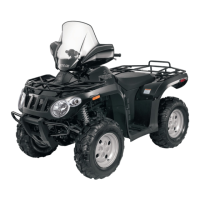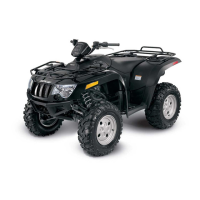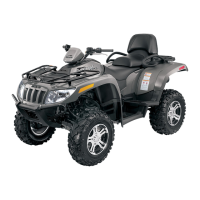Do you have a question about the Arctic Cat 366 2010 and is the answer not in the manual?
General safety warning regarding ATV hazards and operational risks.
Information from Consumer Product Safety Commission on ATV risks and accident statistics.
Details on sponsored ATV riding courses for skill development and safety.
Importance of reading and understanding safety information on ATV hangtags before riding.
Guidance on locating and understanding permanent safety labels on the ATV.
Potential hazards and how to avoid them when operating an ATV without training.
Risks of children under 16 operating an ATV due to lack of skills and judgment.
Dangers of carrying passengers, affecting balance and control, leading to accidents.
ATVs are not designed for pavement; it affects handling and control.
Illegal and dangerous to operate ATVs on public roads due to collision risks.
Importance of helmet, eye protection, and protective clothing to prevent injury.
Severe dangers of alcohol and drug use while operating an ATV.
Risk of losing control and accidents due to high speeds.
Wheelies, jumps, and stunts increase the risk of accidents and rollovers.
Risks of accidents or equipment damage from not inspecting or maintaining the ATV.
Dangers of removing hands from handlebars or feet from footrests while operating.
Need for extra care on unfamiliar terrain to avoid hidden obstacles.
Caution on rough, slippery, or loose terrain to prevent loss of traction and control.
Improper turning can lead to loss of control, collisions, or rollovers.
ATVs can overturn more easily on steep hills than level surfaces.
Overloading affects handling and braking, increasing accident risk.
Improper hill climbing can cause loss of control or ATV overturn.
Improper downhill riding can cause loss of control or ATV overturn.
Risks associated with crossing or turning on hills, potentially causing overturn.
Hazards associated with stalling or rolling backwards while climbing hills.
Risks of operating over obstacles, causing loss of control or overturn.
Losing control due to skidding or sliding on slippery surfaces.
Dangers of operating in deep or fast water, causing loss of control.
Risk of hitting obstacles or people when operating in reverse.
Improper tires or pressure can cause loss of control.
Modifications can change ATV handling, leading to accidents.
Emphasis on prevention techniques to forecast potential hazards before they cause injury.
Importance of wearing appropriate protective clothing and gear for ATV riding.
Critical importance of wearing an approved helmet to prevent severe head injury.
Need for goggles or eye protection to prevent dirt and objects from entering eyes.
Protection from branches, grass, and airborne objects for skin.
Pre-ride checks of tires, controls, cables, lights, oil, fuel, chassis, and miscellaneous items.
Ensuring throttle has a free, smooth range of motion; avoiding sticking throttles.
Checking operation of headlights, taillights, and indicators.
Checking fuel level, oil level, and for fluid leaks before riding.
Cleaning suspension arms, shock springs, fenders, and checking steering.
Inspecting air filter, battery terminals, and tightening parts.
Essential items to carry for emergencies and preparedness on rides.
Importance of carrying a cell phone for urgent calls and communication.
Using maps or GPS for navigation, especially on unfamiliar trails.
Contents of an emergency kit including flashlight, matches, flares, and first aid.
Understanding body weight, balance, and forces affecting ATV handling for safe operation.
Emphasizes using good judgment and assessing personal risk factors before riding.
Considering weather, terrain, and night riding conditions for safe operation.
Warning against operating ATVs on pavement due to altered handling and control.
Tips for selecting appropriate trails and maintaining visibility for safe trail riding.
Understanding various trail signs and symbols for designated trail types and restrictions.
Respecting other riders, vehicles, hikers, and nature while operating the ATV.
Understanding that ATVs have limits and require proper maintenance.
Importance of regular maintenance and consulting a dealer for issues.
Understanding load capacity ratings, tongue weight, and towing limits.
Instructions for installing Speedrack accessories and caution with added loads.
Making safe choices and not exceeding personal or machine capabilities.
Severe dangers of alcohol and drug use while operating an ATV.
Importance of being well-rested and coordinated for safe ATV operation.
Risks associated with speeding and performing stunts.
Adhering to local, state, and provincial ATV laws for safe operation.
Awareness of how group dynamics can influence risk-taking behavior.
Systematic approach to safe riding: Scan, Identify, Predict, Decide, Execute.
Introduction to Division II, covering maintenance, operation, and storage.
Recommendation to use only genuine Arctic Cat parts, oil, and accessories.
Fundamental maneuvers: mounting, starting, braking, shifting, parking, and dismounting.
Step-by-step procedure for starting a cold engine, including primer use.
Procedure for safe and effective braking, including brake fluid checks.
Instructions for shifting between high, low, neutral, and reverse ranges.
Procedure for safely parking the ATV, including on hills.
Steps for safely dismounting the ATV after parking.
Techniques for moving body weight to maintain control during turns and maneuvers.
Method for executing wide turns safely, focusing on throttle and body shifting.
Advanced techniques for sharp turns, emphasizing leaning and weight shift.
Difficult turns for experienced riders, involving handlebar, weight shift, and balance.
Procedure for performing K-turns, useful for stalling or turning on uphills.
Precautions and techniques for safely climbing hills to prevent accidents.
Techniques for safe downhill riding, emphasizing brake use and weight shift.
Advanced skill for riding on slopes; avoidance recommended, but procedure provided.
Emergency reaction technique similar to quick turns, avoiding acceleration.
Guidelines for safely overcoming obstacles like logs and rocks.
Special attention needed for reversing, skidding, parking on hills, and cold weather driving.
Safe practices for reversing, emphasizing slow speed and visibility.
Handling loss of control on slippery surfaces, turning into the slide.
Procedure for parking on a hill, if necessary, including blocking tires.
Steps to take if the ATV stalls or rolls backward while climbing a hill.
Dangers of water ingestion and procedures for crossing water bodies.
Risks and legalities of crossing roads; avoidance is best.
Precautions for operating in cold weather, checking controls and wearing appropriate clothing.
Procedure for stopping the ATV by releasing throttle and applying brakes.
How to shut off the engine using the ignition switch or emergency stop switch.
Location and importance of VIN and ESN for warranty and service.
Information about keys, their identification number, and proper storage.
Operation of the gas tank valve (ON, RES, OFF) and its positions.
Instructions for shifting between high, low, neutral, and reverse ranges.
Engaging or disengaging two-wheel or four-wheel drive.
Operation and function of the hand brake lever and its lock.
Control for selecting high or low headlight beams.
Function of the emergency stop switch for shutting off the engine.
Procedure for starting the engine using the starter button.
Function of the reverse speed limiter override switch.
Control for engine RPM adjustment via throttle lever.
Adjustment of the throttle limiter screw for operator skill.
Operation of the auxiliary brake pedal for rear wheel braking.
Display functions: gear, speed, clock, odometer, and trip meter.
Procedure for using the primer when starting a cold engine.
Maintenance of gas and vent hoses for proper fuel system function.
Procedure for draining the float bowl to remove condensation.
Procedure for checking the engine oil level using the oil level stick.
Procedure for removing and securing the seat using the seat latch.
Information about the provided bracket for mounting a safety flag.
Guidelines for loading front and rear racks, ensuring safety and proper distribution.
Precautions and procedures for trailering and towing with the ATV.
Recommended procedure and precautions for transporting the ATV.
Recommended gasoline, engine oil, and lubricants for the ATV.
Specifications for front differential and rear drive lubricant.
Safe procedures for filling the gas tank, avoiding overfilling and fire hazards.
Instructions for the initial break-in period to ensure engine life and performance.
Importance of the initial break-in period for ATV engine longevity.
Procedure for proper brake pad burnishing to achieve full braking effectiveness.
Schedule for routine inspections, adjustments, and replacements of ATV components.
Importance of cleaning oil cooler fins for proper engine oil cooling.
Inspection of shock absorbers for fluid leakage, cracks, or damage.
Recommendations for lubricating cables and other components.
Procedure for changing engine and transmission oil and filter.
Procedure for inspecting and changing front differential and rear drive lubricant.
Inspection of the hydraulic brake system before each use.
Checking and maintaining brake fluid level in the reservoir.
Checking engagement and function of the brake lever lock.
Inspection of hydraulic brake hoses for cracks or damage.
Checking brake pad thickness and replacement procedure.
Maintenance of the auxiliary brake system for full functionality.
Periodic inspection of protective rubber boots.
Inspection of ball joint boots for damage and free-play.
Inspection of drive axle boots for cracks, tears, or perforations.
Maintenance procedures for batteries, including cleaning and charging.
Procedure for safely jump-starting a vehicle with a dead battery.
Spark plug specifications, inspection, and gap adjustment.
Procedure for adjusting engine idle RPM to the correct operating range.
Procedure for adjusting throttle cable free-play.
Cleaning and inspecting the air filter element for proper engine performance.
Inspection of the air filter housing drain for debris.
Procedure for draining water from the V-belt cover.
Specifications, tread condition, replacement, and repair of ATV tires.
Procedure for removing and installing ATV wheels.
Cleaning the spark arrester periodically.
Procedure for replacing headlights and taillight/brakelight bulbs.
Procedure for replacing taillight and brakelight bulbs.
Procedure for adjusting headlight aim vertically and horizontally.
Location and importance of checking fuses for electrical system failures.
Location of output terminals for electrical accessories.
Information about the provided tool kit and its maintenance.
Owner's responsibility for maintenance and warranty service procedures.
Procedure for updating ownership information or transferring warranty.
Owner's duty to perform required maintenance and proper ATV use.
General safety warning regarding ATV hazards and operational risks.
Information from Consumer Product Safety Commission on ATV risks and accident statistics.
Details on sponsored ATV riding courses for skill development and safety.
Importance of reading and understanding safety information on ATV hangtags before riding.
Guidance on locating and understanding permanent safety labels on the ATV.
Potential hazards and how to avoid them when operating an ATV without training.
Risks of children under 16 operating an ATV due to lack of skills and judgment.
Dangers of carrying passengers, affecting balance and control, leading to accidents.
ATVs are not designed for pavement; it affects handling and control.
Illegal and dangerous to operate ATVs on public roads due to collision risks.
Importance of helmet, eye protection, and protective clothing to prevent injury.
Severe dangers of alcohol and drug use while operating an ATV.
Risk of losing control and accidents due to high speeds.
Wheelies, jumps, and stunts increase the risk of accidents and rollovers.
Risks of accidents or equipment damage from not inspecting or maintaining the ATV.
Dangers of removing hands from handlebars or feet from footrests while operating.
Need for extra care on unfamiliar terrain to avoid hidden obstacles.
Caution on rough, slippery, or loose terrain to prevent loss of traction and control.
Improper turning can lead to loss of control, collisions, or rollovers.
ATVs can overturn more easily on steep hills than level surfaces.
Overloading affects handling and braking, increasing accident risk.
Improper hill climbing can cause loss of control or ATV overturn.
Improper downhill riding can cause loss of control or ATV overturn.
Risks associated with crossing or turning on hills, potentially causing overturn.
Hazards associated with stalling or rolling backwards while climbing hills.
Risks of operating over obstacles, causing loss of control or overturn.
Losing control due to skidding or sliding on slippery surfaces.
Dangers of operating in deep or fast water, causing loss of control.
Risk of hitting obstacles or people when operating in reverse.
Improper tires or pressure can cause loss of control.
Modifications can change ATV handling, leading to accidents.
Emphasis on prevention techniques to forecast potential hazards before they cause injury.
Importance of wearing appropriate protective clothing and gear for ATV riding.
Critical importance of wearing an approved helmet to prevent severe head injury.
Need for goggles or eye protection to prevent dirt and objects from entering eyes.
Protection from branches, grass, and airborne objects for skin.
Pre-ride checks of tires, controls, cables, lights, oil, fuel, chassis, and miscellaneous items.
Ensuring throttle has a free, smooth range of motion; avoiding sticking throttles.
Checking operation of headlights, taillights, and indicators.
Checking fuel level, oil level, and for fluid leaks before riding.
Cleaning suspension arms, shock springs, fenders, and checking steering.
Inspecting air filter, battery terminals, and tightening parts.
Essential items to carry for emergencies and preparedness on rides.
Importance of carrying a cell phone for urgent calls and communication.
Using maps or GPS for navigation, especially on unfamiliar trails.
Contents of an emergency kit including flashlight, matches, flares, and first aid.
Understanding body weight, balance, and forces affecting ATV handling for safe operation.
Emphasizes using good judgment and assessing personal risk factors before riding.
Considering weather, terrain, and night riding conditions for safe operation.
Warning against operating ATVs on pavement due to altered handling and control.
Tips for selecting appropriate trails and maintaining visibility for safe trail riding.
Understanding various trail signs and symbols for designated trail types and restrictions.
Respecting other riders, vehicles, hikers, and nature while operating the ATV.
Understanding that ATVs have limits and require proper maintenance.
Importance of regular maintenance and consulting a dealer for issues.
Understanding load capacity ratings, tongue weight, and towing limits.
Instructions for installing Speedrack accessories and caution with added loads.
Making safe choices and not exceeding personal or machine capabilities.
Severe dangers of alcohol and drug use while operating an ATV.
Importance of being well-rested and coordinated for safe ATV operation.
Risks associated with speeding and performing stunts.
Adhering to local, state, and provincial ATV laws for safe operation.
Awareness of how group dynamics can influence risk-taking behavior.
Systematic approach to safe riding: Scan, Identify, Predict, Decide, Execute.
Introduction to Division II, covering maintenance, operation, and storage.
Recommendation to use only genuine Arctic Cat parts, oil, and accessories.
Fundamental maneuvers: mounting, starting, braking, shifting, parking, and dismounting.
Step-by-step procedure for starting a cold engine, including primer use.
Procedure for safe and effective braking, including brake fluid checks.
Instructions for shifting between high, low, neutral, and reverse ranges.
Procedure for safely parking the ATV, including on hills.
Steps for safely dismounting the ATV after parking.
Techniques for moving body weight to maintain control during turns and maneuvers.
Method for executing wide turns safely, focusing on throttle and body shifting.
Advanced techniques for sharp turns, emphasizing leaning and weight shift.
Difficult turns for experienced riders, involving handlebar, weight shift, and balance.
Procedure for performing K-turns, useful for stalling or turning on uphills.
Precautions and techniques for safely climbing hills to prevent accidents.
Techniques for safe downhill riding, emphasizing brake use and weight shift.
Advanced skill for riding on slopes; avoidance recommended, but procedure provided.
Emergency reaction technique similar to quick turns, avoiding acceleration.
Guidelines for safely overcoming obstacles like logs and rocks.
Special attention needed for reversing, skidding, parking on hills, and cold weather driving.
Safe practices for reversing, emphasizing slow speed and visibility.
Handling loss of control on slippery surfaces, turning into the slide.
Procedure for parking on a hill, if necessary, including blocking tires.
Steps to take if the ATV stalls or rolls backward while climbing a hill.
Dangers of water ingestion and procedures for crossing water bodies.
Risks and legalities of crossing roads; avoidance is best.
Precautions for operating in cold weather, checking controls and wearing appropriate clothing.
Procedure for stopping the ATV by releasing throttle and applying brakes.
How to shut off the engine using the ignition switch or emergency stop switch.
Location and importance of VIN and ESN for warranty and service.
Information about keys, their identification number, and proper storage.
Operation of the gas tank valve (ON, RES, OFF) and its positions.
Instructions for shifting between high, low, neutral, and reverse ranges.
Engaging or disengaging two-wheel or four-wheel drive.
Operation and function of the hand brake lever and its lock.
Control for selecting high or low headlight beams.
Function of the emergency stop switch for shutting off the engine.
Procedure for starting the engine using the starter button.
Function of the reverse speed limiter override switch.
Control for engine RPM adjustment via throttle lever.
Adjustment of the throttle limiter screw for operator skill.
Operation of the auxiliary brake pedal for rear wheel braking.
Display functions: gear, speed, clock, odometer, and trip meter.
Procedure for using the primer when starting a cold engine.
Maintenance of gas and vent hoses for proper fuel system function.
Procedure for draining the float bowl to remove condensation.
Procedure for checking the engine oil level using the oil level stick.
Procedure for removing and securing the seat using the seat latch.
Information about the provided bracket for mounting a safety flag.
Guidelines for loading front and rear racks, ensuring safety and proper distribution.
Precautions and procedures for trailering and towing with the ATV.
Recommended procedure and precautions for transporting the ATV.
Recommended gasoline, engine oil, and lubricants for the ATV.
Specifications for front differential and rear drive lubricant.
Safe procedures for filling the gas tank, avoiding overfilling and fire hazards.
Instructions for the initial break-in period to ensure engine life and performance.
Importance of the initial break-in period for ATV engine longevity.
Procedure for proper brake pad burnishing to achieve full braking effectiveness.
Schedule for routine inspections, adjustments, and replacements of ATV components.
Importance of cleaning oil cooler fins for proper engine oil cooling.
Inspection of shock absorbers for fluid leakage, cracks, or damage.
Recommendations for lubricating cables and other components.
Procedure for changing engine and transmission oil and filter.
Procedure for inspecting and changing front differential and rear drive lubricant.
Inspection of the hydraulic brake system before each use.
Checking and maintaining brake fluid level in the reservoir.
Checking engagement and function of the brake lever lock.
Inspection of hydraulic brake hoses for cracks or damage.
Checking brake pad thickness and replacement procedure.
Maintenance of the auxiliary brake system for full functionality.
Periodic inspection of protective rubber boots.
Inspection of ball joint boots for damage and free-play.
Inspection of drive axle boots for cracks, tears, or perforations.
Maintenance procedures for batteries, including cleaning and charging.
Procedure for safely jump-starting a vehicle with a dead battery.
Spark plug specifications, inspection, and gap adjustment.
Procedure for adjusting engine idle RPM to the correct operating range.
Procedure for adjusting throttle cable free-play.
Cleaning and inspecting the air filter element for proper engine performance.
Inspection of the air filter housing drain for debris.
Procedure for draining water from the V-belt cover.
Specifications, tread condition, replacement, and repair of ATV tires.
Procedure for removing and installing ATV wheels.
Cleaning the spark arrester periodically.
Procedure for replacing headlights and taillight/brakelight bulbs.
Procedure for replacing taillight and brakelight bulbs.
Procedure for adjusting headlight aim vertically and horizontally.
Location and importance of checking fuses for electrical system failures.
Location of output terminals for electrical accessories.
Information about the provided tool kit and its maintenance.
Owner's responsibility for maintenance and warranty service procedures.
Procedure for updating ownership information or transferring warranty.
Owner's duty to perform required maintenance and proper ATV use.
| Brand | Arctic Cat |
|---|---|
| Model | 366 2010 |
| Category | Offroad Vehicle |
| Language | English |











